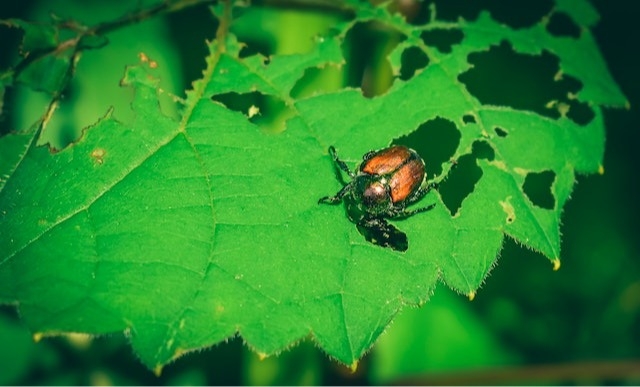A Guide to Japanese Beetles
When you think of pests common in your yard, you probably focus on insects like moths, bark beetles, and other easy-to-spot culprits. Though these insects are problematic for your landscaping, they’re not the only ones you need to worry about. Japanese beetles can be some of the most destructive pests in your yard, and they’re on the rise in the greater Denver area. Here’s what your tree health care team wants you to know so you can better deal with these unwanted insects.
What Are Japanese Beetles?
Japanese beetles are a type of beetle that feeds on the leaves, fruit, and flowers of many common plant species in the Denver metro area. They’re native to Japan and are considered an invasive species in the United States, which means getting rid of them should be a priority for Denver homeowners.
These pests have very few natural predators in the area, and they’re able to spread quickly once they start breeding on your property.
What Do They Do to Your Plants?
Unlike other common beetles, Japanese beetles don’t necessarily kill trees and plants on your property. This is because they feed on the leaves, flowers, and fruit of the plant rather than the roots. Typically, they’ll only cause cosmetic damage, and as long as the plants in your yard are healthy and mature, they should be able to survive a full Japanese beetle infestation without issue.
These beetles can feed on almost any plant, but they tend to prefer flowering bushes like rose plants and hollyhocks, crabapple, apple, birch, elm, and plum trees, and food plants like basil, currants, and soybeans. As they feed, they create a lace-like pattern on the leaves.
How to Get Rid of Them
One of the most time-consuming yet effective ways to get rid of Japanese beetles is to remove them by hand. These insects are large enough that you’ll be able to see them crawling around on the leaves and feeding on blooms. You may also be able to cover younger or less-mature plants with a breathable mesh to keep the beetles from reaching the leaves. Keep in mind that you should only cover non-flowering plants, as the mesh will damage any existing blooms and will prevent pollination.
If there are more beetles than you’re comfortable dealing with on your own, your tree health care specialist will be able to treat your plants.
Tips for Keeping Them Away
The easiest way to prevent Japanese beetles is to be proactive and start removing beetles as soon as you notice them. Use preventative sprays like water with Neem oil or diluted dish soap to get rid of them without the use of dangerous over-the-counter pesticides. You’ll also want to schedule regular appointments with your tree care team to let them treat your yard and identify the best preventative measures to protect your plants.
Let Your Tree Health Care Team Help
If you think you have a Japanese beetle problem on your property, don’t ignore it. Contact the team at Root Tree Service today and let our experienced specialists help. We’ll identify the extent of the infestation and create a treatment plan that will work for your yard.
Go Back What Are Japanese Beetles?
Japanese beetles are a type of beetle that feeds on the leaves, fruit, and flowers of many common plant species in the Denver metro area. They’re native to Japan and are considered an invasive species in the United States, which means getting rid of them should be a priority for Denver homeowners.
These pests have very few natural predators in the area, and they’re able to spread quickly once they start breeding on your property.
What Do They Do to Your Plants?
Unlike other common beetles, Japanese beetles don’t necessarily kill trees and plants on your property. This is because they feed on the leaves, flowers, and fruit of the plant rather than the roots. Typically, they’ll only cause cosmetic damage, and as long as the plants in your yard are healthy and mature, they should be able to survive a full Japanese beetle infestation without issue.
These beetles can feed on almost any plant, but they tend to prefer flowering bushes like rose plants and hollyhocks, crabapple, apple, birch, elm, and plum trees, and food plants like basil, currants, and soybeans. As they feed, they create a lace-like pattern on the leaves.
How to Get Rid of Them
One of the most time-consuming yet effective ways to get rid of Japanese beetles is to remove them by hand. These insects are large enough that you’ll be able to see them crawling around on the leaves and feeding on blooms. You may also be able to cover younger or less-mature plants with a breathable mesh to keep the beetles from reaching the leaves. Keep in mind that you should only cover non-flowering plants, as the mesh will damage any existing blooms and will prevent pollination.
If there are more beetles than you’re comfortable dealing with on your own, your tree health care specialist will be able to treat your plants.
Tips for Keeping Them Away
The easiest way to prevent Japanese beetles is to be proactive and start removing beetles as soon as you notice them. Use preventative sprays like water with Neem oil or diluted dish soap to get rid of them without the use of dangerous over-the-counter pesticides. You’ll also want to schedule regular appointments with your tree care team to let them treat your yard and identify the best preventative measures to protect your plants.
Let Your Tree Health Care Team Help
If you think you have a Japanese beetle problem on your property, don’t ignore it. Contact the team at Root Tree Service today and let our experienced specialists help. We’ll identify the extent of the infestation and create a treatment plan that will work for your yard.
